
Bioactive Marine Natural Products D.S.Bhakuni Central Drug Rese D.S.Rawat Department of Chemistrv University of Delhi,Delhi,India Springer Anamaya
Anamaya Bioactive Marine Natural Products D.S. Bhakuni Central Drug Research Institute Lucknow, India D.S. Rawat Department of Chemistry University of Delhi, Delhi, India Springer

Foreword The cher y of marine natural products has s these must be volatile,their chemical structures are often simple and many are easy to synthesize.In contrast,in an aqueous environment communication between living organisms depends on solubility in water.As a consequence,the chemica compounds used in the communication can have complex structures and large ve comp city.there are ractive to s to the omplicated.What is ed by the given all these factors it is not sumprising that marine organisms are a wonderful source of biologically active natural products.It has taken half a century for this to be fully appreciated.In this time the means of collection have been developed so that marine diving.at least in shallow coastal waters.is relatively simple an ava nche of ne there if th often avai am re is comp erial for clinical ials Th: synthetic chemist e to the help of the clinician.Marine natural products The present hook by dr ds Bhakuni a distinguished exnert on natura osgas a description of the compounds and their biosynthesis.Of course,there can be no clinical discovery without prior and extensive biological testing so these
Foreword The chemistry of marine natural products has grown enormously in the last fifty years. On land, communication between insects is largely by pheromones. Because these must be volatile, their chemical structures are often simple and many are easy to synthesize. In contrast, in an aqueous environment communication between living organisms depends on solubility in water. As a consequence, the chemical compounds used in the communication can have complex structures and large molecular weights as long as there is adequate solubility in water. Since all forms of life are subject to perpetual competition, it is not surprising that the organisms that live in the sea produce an enormous range of biological activity. Besides the compounds that repel predators by their toxicity, there are those which are attractive to make reproduction more probable. In addition, there is a complex food chain from the simplest organisms to the most complicated. What is edible and what is not is also determined by the secondary metabolites of the life process. Given all these factors it is not surprising that marine organisms are a wonderful source of biologically active natural products. It has taken half a century for this to be fully appreciated. In this time the means of collection have been developed so that marine diving, at least in shallow coastal waters, is relatively simple. Also, more sensitive biological tests are available and can be carried out on board ship. The result of all this is that there is an avalanche of new and biologically exciting marine natural products. However, there is one negative aspect to this work. It is that the compounds isolated are often available in minute amounts only. Therefore, if the structure is complex, it is an arduous, and often impossible, task to isolate enough of the natural material for clinical trials. This is where synthetic chemistry can come to the help of the clinician. Marine natural products are often wonderful challenges to synthetic chemists. The present book by Dr. D.S. Bhakuni, a distinguished expert on natural products chemistry, [and Dr. D.S. Rawat] will serve as an excellent introduction to the scientific methods involved in marine natural products chemistry. It includes a description of the compounds and their biosynthesis. Of course, there can be no clinical discovery without prior and extensive biological testing so these
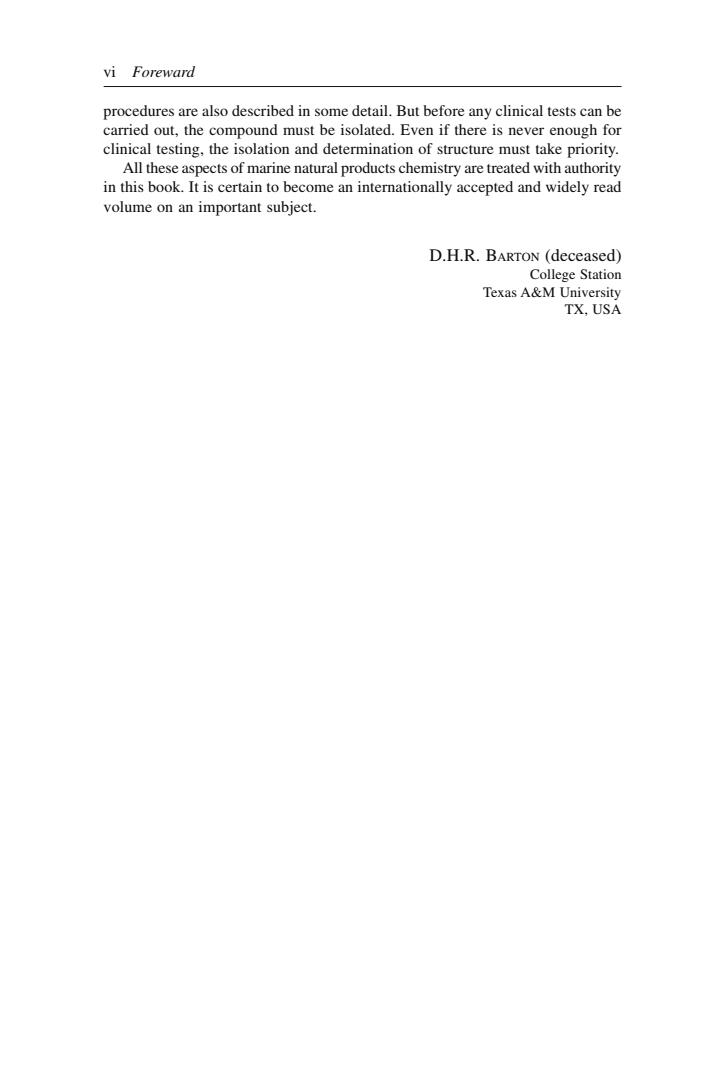
vi Foreward procedures are also described in some detail.But before any clinical tests can be earried out,the compound must be isolated.Even if there is never enough for clinical testing,the isolation and determination of structure must take priority ecome an internatic
procedures are also described in some detail. But before any clinical tests can be carried out, the compound must be isolated. Even if there is never enough for clinical testing, the isolation and determination of structure must take priority. All these aspects of marine natural products chemistry are treated with authority in this book. It is certain to become an internationally accepted and widely read volume on an important subject. D.H.R. BARTON (deceased) College Station Texas A&M University TX, USA vi Foreward

Preface Marine natural products have attracted the attention of biologists and che nists the world over for the ast five decades.To date approximately600maintura products have been isolated from marine organ 6.800publications.In addition tothesepublicationsthere areapproximately another 9.000 publications which cover syntheses.reviews.biological activity studies ecological studies etc.on the subject of marine natural products.Several of the cdeofviy e o ceutically useful o npounds bu tificatio b of sea poradic and produc dictable h use toxic fish o toxins are produced by microorganisms such as dinoflagellates or marine bacteria and may pass through several levels ofthe food chain.The identification of marine oxins has been one of the most challenging areas of marine natural products hemistry. decde major occupation of marine naural products chemists for the past two nthe search f or potential pharmaceutical difficult to single that is c fin a place in medicine hown promise ns produce som for drug develo y toprovide ent studie Marine environment provides different biosynthetic conditions to organisms tha live in it marine organisms generally live in symbiotic association.the pathway of transfer of nutrients between symbiotic partners is of much importance and raises questions about the real origin of metabolites produced by association A recent trend in marine natural products chemistry is the study of symbiosis. oof bioacuve marne natural products provides many chalng
Preface Marine natural products have attracted the attention of biologists and chemists the world over for the last five decades. To date approximately 16,000 marine natural products have been isolated from marine organisms and reported in approximately 6,800 publications. In addition to these publications there are approximately another 9,000 publications which cover syntheses, reviews, biological activity studies, ecological studies etc. on the subject of marine natural products. Several of the compounds isolated from marine source exhibit biological activity. The ocean is considered to be a source of potential drugs. Marine organisms not only elaborate pharmaceutically useful compounds but also produce toxic substances. One of the most important societal contribution of marine natural products chemists has been the isolation and identification of toxins responsible for seafood poisoning. Outbreaks of seafood poisoning are usually sporadic and unpredictable because toxic fish or shellfish do not produce the toxins themselves, but concentrate them from organisms that they eat. Most marine toxins are produced by microorganisms such as dinoflagellates or marine bacteria and may pass through several levels of the food chain. The identification of marine toxins has been one of the most challenging areas of marine natural products chemistry. The major occupation of marine natural products chemists for the past two decades has been the search for potential pharmaceuticals. It is difficult to single out a particular bioactive molecule that is destined to find a place in medicine. However, many compounds have shown promise. Marine organisms produce some of the most cytotoxic compounds ever discovered, but the yields of these compounds are invariably so small that natural sources are unlikely to provide enough material for drug development studies. The art by which marine organisms elaborate bioactive molecules is fascinating. Marine environment provides different biosynthetic conditions to organisms that live in it. Marine organisms generally live in symbiotic association. The pathway of transfer of nutrients between symbiotic partners is of much importance and raises questions about the real origin of metabolites produced by association. A recent trend in marine natural products chemistry is the study of symbiosis. Biosynthesis of bioactive marine natural products provides many challenging problems
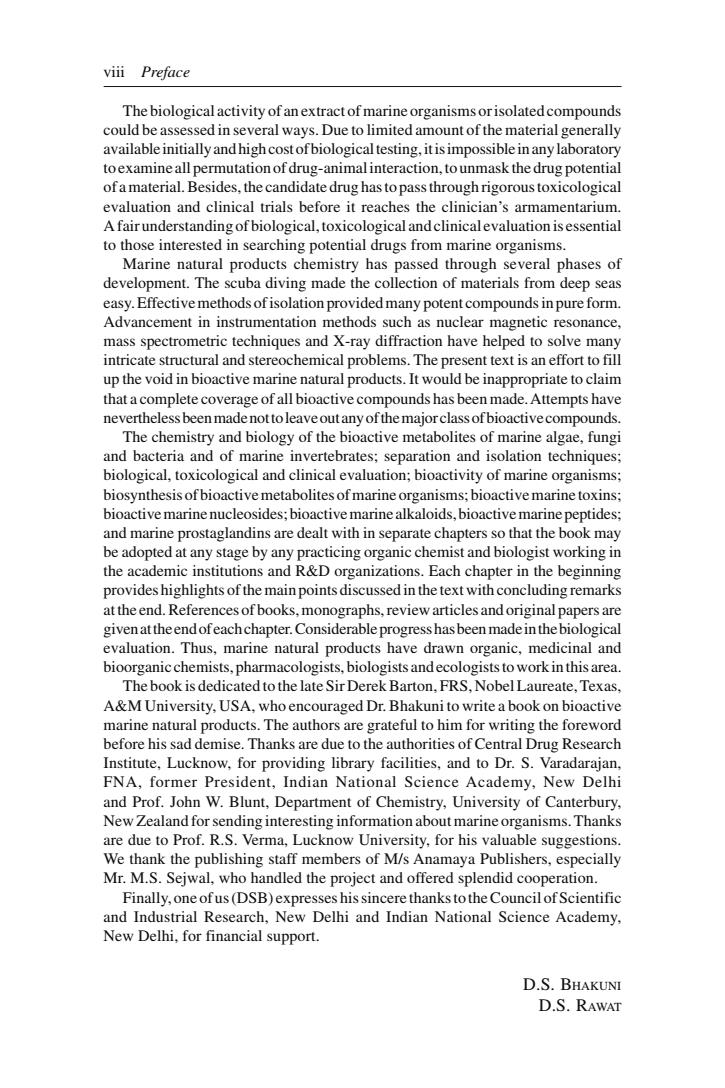
viii Preface The biologicalactivity of anextract of marine organismsorisolatedcompounds could be assessed in several ways.Due to limited amount of the material generally available initiallyandhighcostofbiologicaltesting,itisimpossible inany laboratory toexamineallpermutationodrg-anmalinteracton.tounm of a mater rug ha 21 the tho ed ofbr and ugs fr Marine natural products chemistry has ed through several phases of develonment the scuba diving made the collection of materials from deep seas easy.Effective methodsof isolation provided many potent compounds in pure form. Advancement in instrumentation methods such as nuclear magnetic resonance mass spectrometric techniques and X-ray diffraction have helped to solve many intricate structural and stereochemical problems.The present text is an effort to fil up the void in bioactive marine natural products.It would be inappropriate toclaim aof all bioactive compounds hasbeen mad Attempts have eoayoftcmeboies ep. nd el .h activity of m rin fhi hioactive marine nucleosideshioactive marinealkaloids hioactive marine tides and marine prostaglandins are dealt with in separate chapters so that the book mav be adopted at any stage by any practicing organic chemist and biologist working in the academic institutions and R&D organizations.Each chapter in the beginning provides highlights of the main points discussed in the text with concluding remark at the end.References of books,monographs,review articles andoriginal papers are givenattheendofeachchapter.Conside ble progresshasbeen ma organic. biologic aluat a and an n.FRS.Nob to T ed Dr B narine natural nducts The a ateful to hi writing the fo before his sad demise.Thanks are due to the authorities of central drug re Institute lucknow for providing library facilities and to Dr s varadaraian FNA,former President,Indian National Science Academy,New Delhi and Prof.John W.Blunt.Department of Chemistry.University of Canterbury New Zealand for sending interesting information about marine organisms.Thanks are due to Prof.R.S.Verma,Lucknow University,for his valuable suggestior M he pub members of M/s a Pu ject and offe us(DSB an uppo D.S.BHAKUNI DS RAWAT
The biological activity of an extract of marine organisms or isolated compounds could be assessed in several ways. Due to limited amount of the material generally available initially and high cost of biological testing, it is impossible in any laboratory to examine all permutation of drug-animal interaction, to unmask the drug potential of a material. Besides, the candidate drug has to pass through rigorous toxicological evaluation and clinical trials before it reaches the clinician’s armamentarium. A fair understanding of biological, toxicological and clinical evaluation is essential to those interested in searching potential drugs from marine organisms. Marine natural products chemistry has passed through several phases of development. The scuba diving made the collection of materials from deep seas easy. Effective methods of isolation provided many potent compounds in pure form. Advancement in instrumentation methods such as nuclear magnetic resonance, mass spectrometric techniques and X-ray diffraction have helped to solve many intricate structural and stereochemical problems. The present text is an effort to fill up the void in bioactive marine natural products. It would be inappropriate to claim that a complete coverage of all bioactive compounds has been made. Attempts have nevertheless been made not to leave out any of the major class of bioactive compounds. The chemistry and biology of the bioactive metabolites of marine algae, fungi and bacteria and of marine invertebrates; separation and isolation techniques; biological, toxicological and clinical evaluation; bioactivity of marine organisms; biosynthesis of bioactive metabolites of marine organisms; bioactive marine toxins; bioactive marine nucleosides; bioactive marine alkaloids, bioactive marine peptides; and marine prostaglandins are dealt with in separate chapters so that the book may be adopted at any stage by any practicing organic chemist and biologist working in the academic institutions and R&D organizations. Each chapter in the beginning provides highlights of the main points discussed in the text with concluding remarks at the end. References of books, monographs, review articles and original papers are given at the end of each chapter. Considerable progress has been made in the biological evaluation. Thus, marine natural products have drawn organic, medicinal and bioorganic chemists, pharmacologists, biologists and ecologists to work in this area. The book is dedicated to the late Sir Derek Barton, FRS, Nobel Laureate, Texas, A&M University, USA, who encouraged Dr. Bhakuni to write a book on bioactive marine natural products. The authors are grateful to him for writing the foreword before his sad demise. Thanks are due to the authorities of Central Drug Research Institute, Lucknow, for providing library facilities, and to Dr. S. Varadarajan, FNA, former President, Indian National Science Academy, New Delhi and Prof. John W. Blunt, Department of Chemistry, University of Canterbury, New Zealand for sending interesting information about marine organisms. Thanks are due to Prof. R.S. Verma, Lucknow University, for his valuable suggestions. We thank the publishing staff members of M/s Anamaya Publishers, especially Mr. M.S. Sejwal, who handled the project and offered splendid cooperation. Finally, one of us (DSB) expresses his sincere thanks to the Council of Scientific and Industrial Research, New Delhi and Indian National Science Academy, New Delhi, for financial support. D.S. BHAKUNI D.S. RAWAT viii Preface
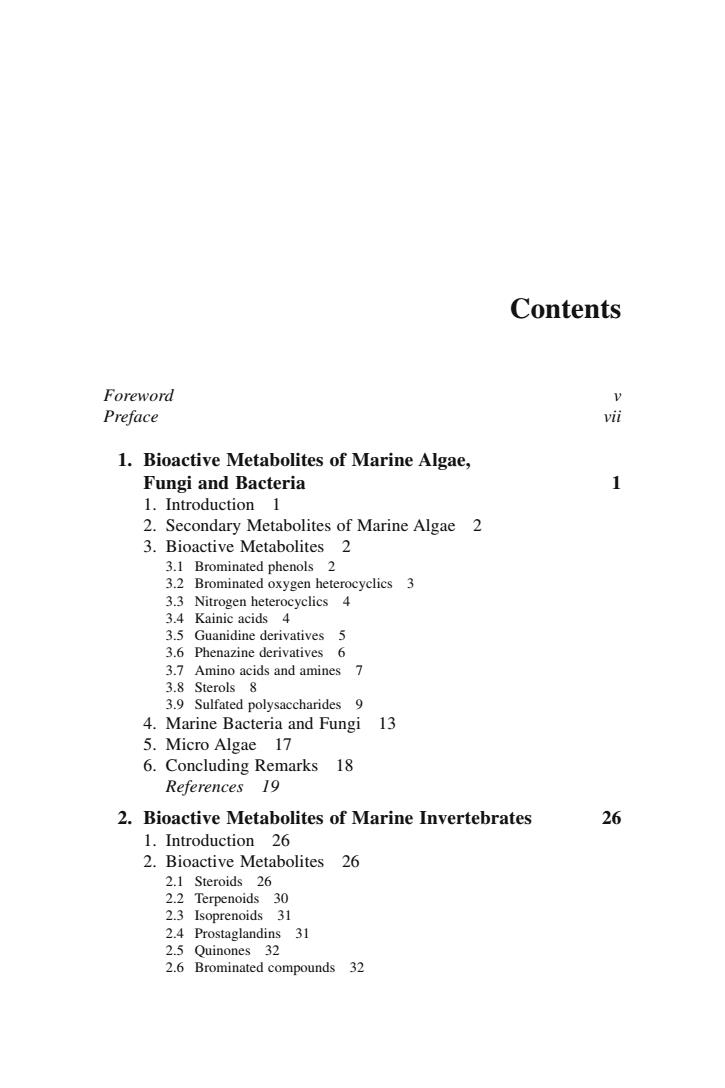
Contents Foreword Preface 1.Bioactive Metabolites of Marine Algae, Fungi and bacteria 1 Introduction 1 2.Secondary Metabolites of Marine Algae 2 3.2 Brominated oxygen heterocyclics 3 3.3 Nitrogen heterocyclics 4 atives 5 3.6 Phenazine derivatives6 3.Sulfated polysaccharides9 4.Marine Bacteria and Fungi 13 5.Micro Algae 17 6.Concluding Remarks 18 References 10 2.Bioactive Metabolites of Marine Invertebrates 26 1.Introduction 26 2.Bioactive Metabolites 26 2.1 Steroids 26 2.4 Prostaglandins 31
Contents Foreword v Preface vii 1. Bioactive Metabolites of Marine Algae, Fungi and Bacteria 1 1. Introduction 1 2. Secondary Metabolites of Marine Algae 2 3. Bioactive Metabolites 2 3.1 Brominated phenols 2 3.2 Brominated oxygen heterocyclics 3 3.3 Nitrogen heterocyclics 4 3.4 Kainic acids 4 3.5 Guanidine derivatives 5 3.6 Phenazine derivatives 6 3.7 Amino acids and amines 7 3.8 Sterols 8 3.9 Sulfated polysaccharides 9 4. Marine Bacteria and Fungi 13 5. Micro Algae 17 6. Concluding Remarks 18 References 19 2. Bioactive Metabolites of Marine Invertebrates 26 1. Introduction 26 2. Bioactive Metabolites 26 2.1 Steroids 26 2.2 Terpenoids 30 2.3 Isoprenoids 31 2.4 Prostaglandins 31 2.5 Quinones 32 2.6 Brominated compounds 32
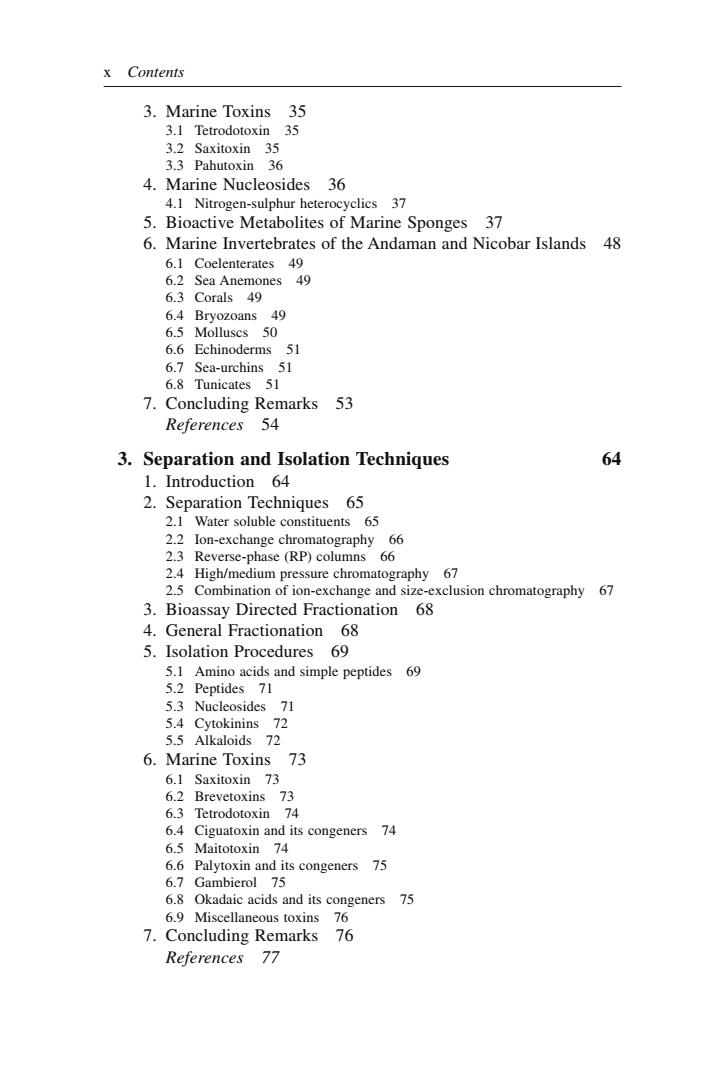
x Contents 3.Marine Toxins 35 3.1 Tetrodotoxin 35 4.Marine Nucleosides 36 4.1 Nitrogen-sulphur heterocyclics 37 5.Bioactive Metabolites of Marine Sponges 37 6.Marine Invertebrates of the Andaman and Nicobar Islands 48 6.1 Coelenterates 49 rals 66 Echinod 7.Concluding Remarks 53 References 54 3.Separation and Isolation Techniques 64 1.Introduction 64 2.Separation Techniques 65 2.1 Water soluble constituents 65 2 on-exchange ch phy 67 2.5 Combination of ion-exchange and size exclusion chromatography 67 3.Bioassay Directed Fractionation 68 4.General Fractionation 68 5.Isolation Procedures 69 71 5.4 Cytokinins 72 5.5 Alkaloids 6.Marine Toxins 73 nd Is congeners 75 75 Oadaic acids and its 7.Concluding Remarks References 77
x Contents 3. Marine Toxins 35 3.1 Tetrodotoxin 35 3.2 Saxitoxin 35 3.3 Pahutoxin 36 4. Marine Nucleosides 36 4.1 Nitrogen-sulphur heterocyclics 37 5. Bioactive Metabolites of Marine Sponges 37 6. Marine Invertebrates of the Andaman and Nicobar Islands 48 6.1 Coelenterates 49 6.2 Sea Anemones 49 6.3 Corals 49 6.4 Bryozoans 49 6.5 Molluscs 50 6.6 Echinoderms 51 6.7 Sea-urchins 51 6.8 Tunicates 51 7. Concluding Remarks 53 References 54 3. Separation and Isolation Techniques 64 1. Introduction 64 2. Separation Techniques 65 2.1 Water soluble constituents 65 2.2 Ion-exchange chromatography 66 2.3 Reverse-phase (RP) columns 66 2.4 High/medium pressure chromatography 67 2.5 Combination of ion-exchange and size-exclusion chromatography 67 3. Bioassay Directed Fractionation 68 4. General Fractionation 68 5. Isolation Procedures 69 5.1 Amino acids and simple peptides 69 5.2 Peptides 71 5.3 Nucleosides 71 5.4 Cytokinins 72 5.5 Alkaloids 72 6. Marine Toxins 73 6.1 Saxitoxin 73 6.2 Brevetoxins 73 6.3 Tetrodotoxin 74 6.4 Ciguatoxin and its congeners 74 6.5 Maitotoxin 74 6.6 Palytoxin and its congeners 75 6.7 Gambierol 75 6.8 Okadaic acids and its congeners 75 6.9 Miscellaneous toxins 76 7. Concluding Remarks 76 References 77
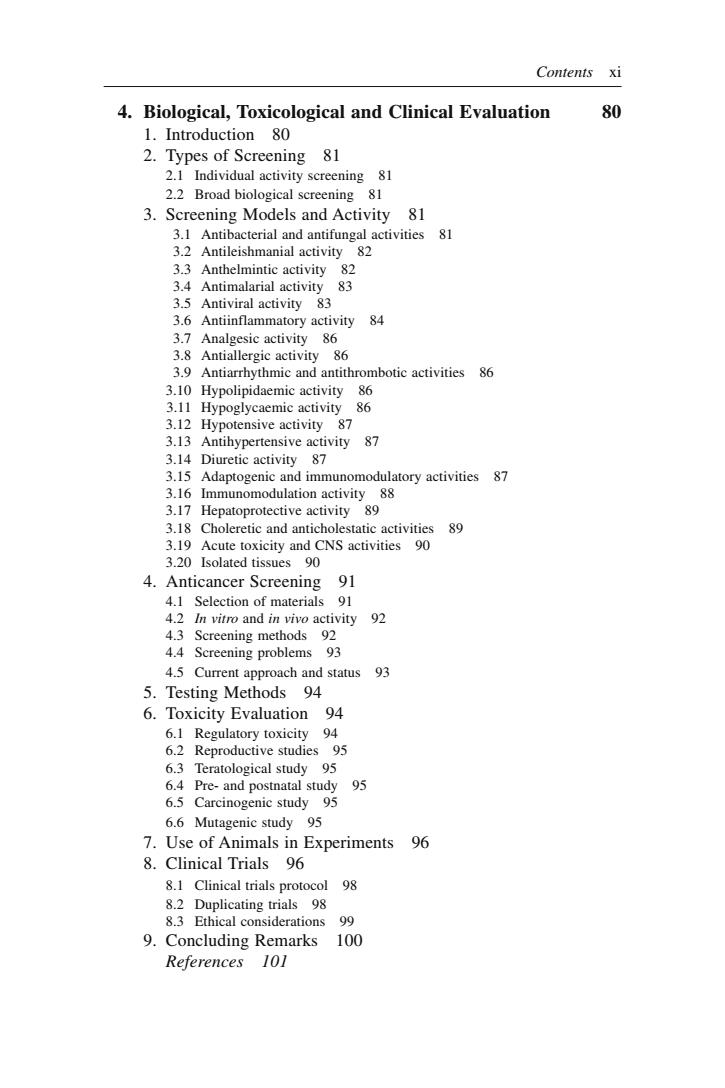
Contents xi 4.Biological,Toxicological and Clinical Evaluation 80 1.Introduction 80 ning 81 Individual ac ning 8l 2.2 Broad biological screening 81 3.Scr ing Models and Activity 81 站 rial and antifungal activities 81 82 3 5 Antiviral activity 83 3.6 Antiinflammatory activity 84 3.9 Antiarrhythmic and antithrombotic activities 86 86 87 tivity 87 314 Diuretic ac vity 3.16 Immunomodulation activity modulatory activities87 88 3.17 Hepatoprotective activity 89 9 eretic and ar nd CNS 89 3.20 Isolated tissues 90 4. Anticancer Screening 91 91 43 nd 4.4 Screening problems 93 4.5 Current approach and status 93 5.Testing Methods 94 6.Toxicity Evaluation 94 6.1 Regulatory toxicity 94 6.2 Reproductive studies gic 6.5 Carcinogenic study 5 6.6 Mutagenic study 95 7.Use of Animals in Experiments 96 8.Clinical Trials 96 8.1 Clinical trials protocol98 8.2 Duplicating trials 98 8.3 Ethical considerations 99 9.Concluding Remarks 100 References 101
Contents xi 4. Biological, Toxicological and Clinical Evaluation 80 1. Introduction 80 2. Types of Screening 81 2.1 Individual activity screening 81 2.2 Broad biological screening 81 3. Screening Models and Activity 81 3.1 Antibacterial and antifungal activities 81 3.2 Antileishmanial activity 82 3.3 Anthelmintic activity 82 3.4 Antimalarial activity 83 3.5 Antiviral activity 83 3.6 Antiinflammatory activity 84 3.7 Analgesic activity 86 3.8 Antiallergic activity 86 3.9 Antiarrhythmic and antithrombotic activities 86 3.10 Hypolipidaemic activity 86 3.11 Hypoglycaemic activity 86 3.12 Hypotensive activity 87 3.13 Antihypertensive activity 87 3.14 Diuretic activity 87 3.15 Adaptogenic and immunomodulatory activities 87 3.16 Immunomodulation activity 88 3.17 Hepatoprotective activity 89 3.18 Choleretic and anticholestatic activities 89 3.19 Acute toxicity and CNS activities 90 3.20 Isolated tissues 90 4. Anticancer Screening 91 4.1 Selection of materials 91 4.2 In vitro and in vivo activity 92 4.3 Screening methods 92 4.4 Screening problems 93 4.5 Current approach and status 93 5. Testing Methods 94 6. Toxicity Evaluation 94 6.1 Regulatory toxicity 94 6.2 Reproductive studies 95 6.3 Teratological study 95 6.4 Pre- and postnatal study 95 6.5 Carcinogenic study 95 6.6 Mutagenic study 95 7. Use of Animals in Experiments 96 8. Clinical Trials 96 8.1 Clinical trials protocol 98 8.2 Duplicating trials 98 8.3 Ethical considerations 99 9. Concluding Remarks 100 References 101
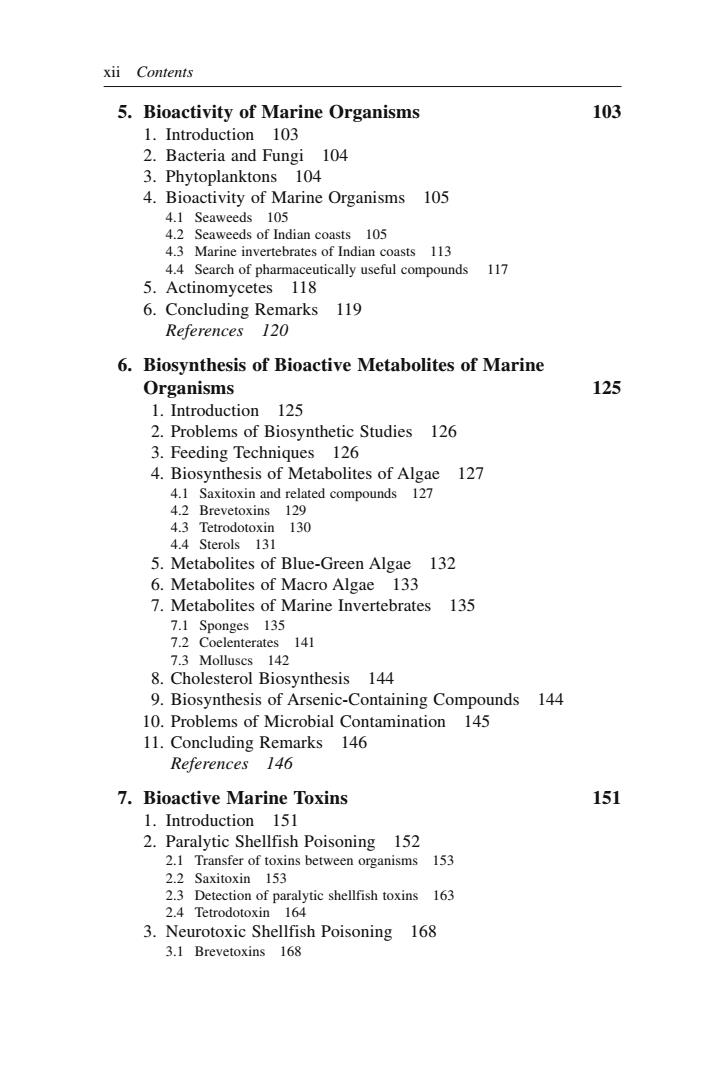
xii Contents 5.Bioactivity of Marine Organisms 103 1.Introduction 103 2.Bacteria and Fungi 104 lankton 104 105 5. ctimomycre17 Actinomycetes 6.Concluding Remarks 119 References 120 6.Biosynthesis of Bioactive Metabolites of Marine Organisms 125 1.Introduction 125 2.Problems of Biosynthetic Studies 126 3.Feeding Techniques 126 4.Biosynthesis of Metabolites of Algae 127 4.1 Saxitoxin and related compounds 127 rols 131 5.Metabolites of Blue-Green Algae 132 6.Metabolites of Macro Algae 133 7.Metabolites of Marine Invertebrates 135 135 141 144 9.Biosynthesis of Arsenic-Containing Compounds 144 10.Problems of Microbial Contamination 145 11.Concluding Remarks 146 References 146 7.Bioactive Marine Toxins 151 1.Introduction 151 2.Paralytic Shellfish Poisoning 152 2.1 Transfer of toxins between organisms 153 3.Neurotoxic Shellfish Poisoning 168 3.1 Brevetoxins 168
xii Contents 5. Bioactivity of Marine Organisms 103 1. Introduction 103 2. Bacteria and Fungi 104 3. Phytoplanktons 104 4. Bioactivity of Marine Organisms 105 4.1 Seaweeds 105 4.2 Seaweeds of Indian coasts 105 4.3 Marine invertebrates of Indian coasts 113 4.4 Search of pharmaceutically useful compounds 117 5. Actinomycetes 118 6. Concluding Remarks 119 References 120 6. Biosynthesis of Bioactive Metabolites of Marine Organisms 125 1. Introduction 125 2. Problems of Biosynthetic Studies 126 3. Feeding Techniques 126 4. Biosynthesis of Metabolites of Algae 127 4.1 Saxitoxin and related compounds 127 4.2 Brevetoxins 129 4.3 Tetrodotoxin 130 4.4 Sterols 131 5. Metabolites of Blue-Green Algae 132 6. Metabolites of Macro Algae 133 7. Metabolites of Marine Invertebrates 135 7.1 Sponges 135 7.2 Coelenterates 141 7.3 Molluscs 142 8. Cholesterol Biosynthesis 144 9. Biosynthesis of Arsenic-Containing Compounds 144 10. Problems of Microbial Contamination 145 11. Concluding Remarks 146 References 146 7. Bioactive Marine Toxins 151 1. Introduction 151 2. Paralytic Shellfish Poisoning 152 2.1 Transfer of toxins between organisms 153 2.2 Saxitoxin 153 2.3 Detection of paralytic shellfish toxins 163 2.4 Tetrodotoxin 164 3. Neurotoxic Shellfish Poisoning 168 3.1 Brevetoxins 168
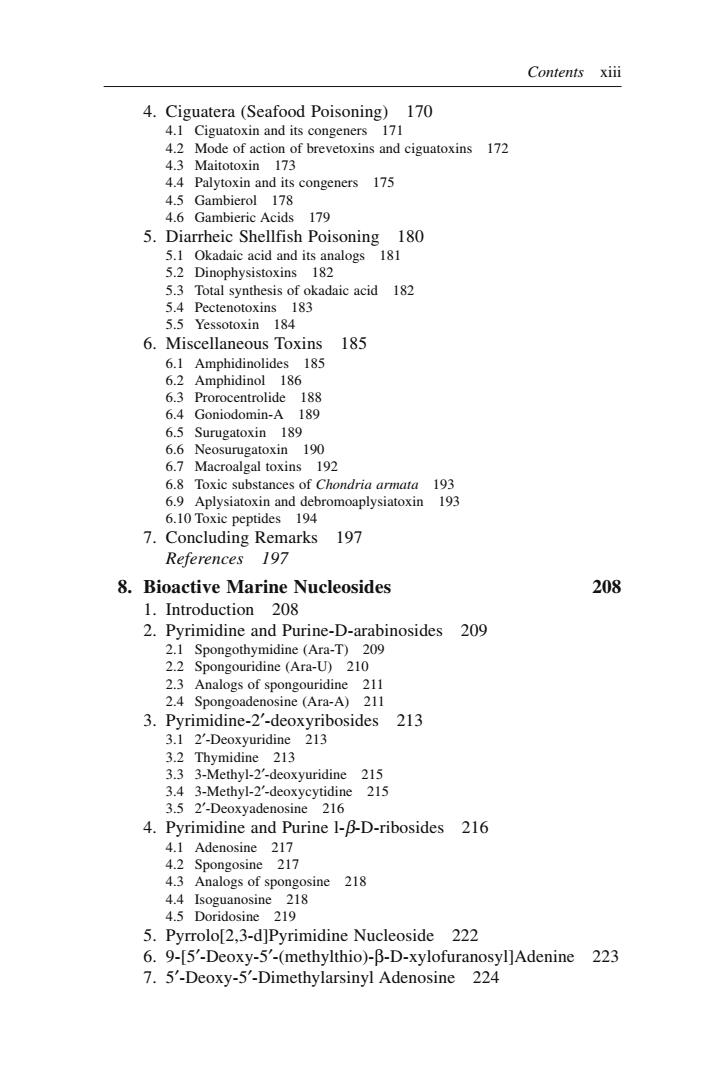
Contents xiii 4.Ciguatera(Seafood Poisoning)170 4.1 Ciguatoxin and its congeners 171 4.4 Palytoxin and its congeners 175 aheic Shellfish Poiso 179 5.Dia ish Po 180 181 6.Miscellaneous Toxins 185 6.1 Amphidinolides 185 ,186 6.5 Surugatoxin 189 6.5 190 es of Chondria 1193 197 8.Bioactive Marine Nucleosides 208 1.Introduction 208 2.Pyrimidine and Purine-D-arabinosides 209 2.3 Analogs of spo ngouridine 211 2-deoxvuridine 215 3.3-Methyl-2-deoxyeytidine 215 oxyad 8 ne an Pu rine 1-B-D-ribosides 216 5 Pyrrolol2 3-dIPyrimidine Nucleoside 222 95-De y-5'-(methylthio)-B-D-xylofuran nethyl arsinyl Adenosine
Contents xiii 4. Ciguatera (Seafood Poisoning) 170 4.1 Ciguatoxin and its congeners 171 4.2 Mode of action of brevetoxins and ciguatoxins 172 4.3 Maitotoxin 173 4.4 Palytoxin and its congeners 175 4.5 Gambierol 178 4.6 Gambieric Acids 179 5. Diarrheic Shellfish Poisoning 180 5.1 Okadaic acid and its analogs 181 5.2 Dinophysistoxins 182 5.3 Total synthesis of okadaic acid 182 5.4 Pectenotoxins 183 5.5 Yessotoxin 184 6. Miscellaneous Toxins 185 6.1 Amphidinolides 185 6.2 Amphidinol 186 6.3 Prorocentrolide 188 6.4 Goniodomin-A 189 6.5 Surugatoxin 189 6.6 Neosurugatoxin 190 6.7 Macroalgal toxins 192 6.8 Toxic substances of Chondria armata 193 6.9 Aplysiatoxin and debromoaplysiatoxin 193 6.10 Toxic peptides 194 7. Concluding Remarks 197 References 197 8. Bioactive Marine Nucleosides 208 1. Introduction 208 2. Pyrimidine and Purine-D-arabinosides 209 2.1 Spongothymidine (Ara-T) 209 2.2 Spongouridine (Ara-U) 210 2.3 Analogs of spongouridine 211 2.4 Spongoadenosine (Ara-A) 211 3. Pyrimidine-2′-deoxyribosides 213 3.1 2′-Deoxyuridine 213 3.2 Thymidine 213 3.3 3-Methyl-2′-deoxyuridine 215 3.4 3-Methyl-2′-deoxycytidine 215 3.5 2′-Deoxyadenosine 216 4. Pyrimidine and Purine l-β-D-ribosides 216 4.1 Adenosine 217 4.2 Spongosine 217 4.3 Analogs of spongosine 218 4.4 Isoguanosine 218 4.5 Doridosine 219 5. Pyrrolo[2,3-d]Pyrimidine Nucleoside 222 6. 9-[5′-Deoxy-5′-(methylthio)-β-D-xylofuranosyl]Adenine 223 7. 5′-Deoxy-5′-Dimethylarsinyl Adenosine 224